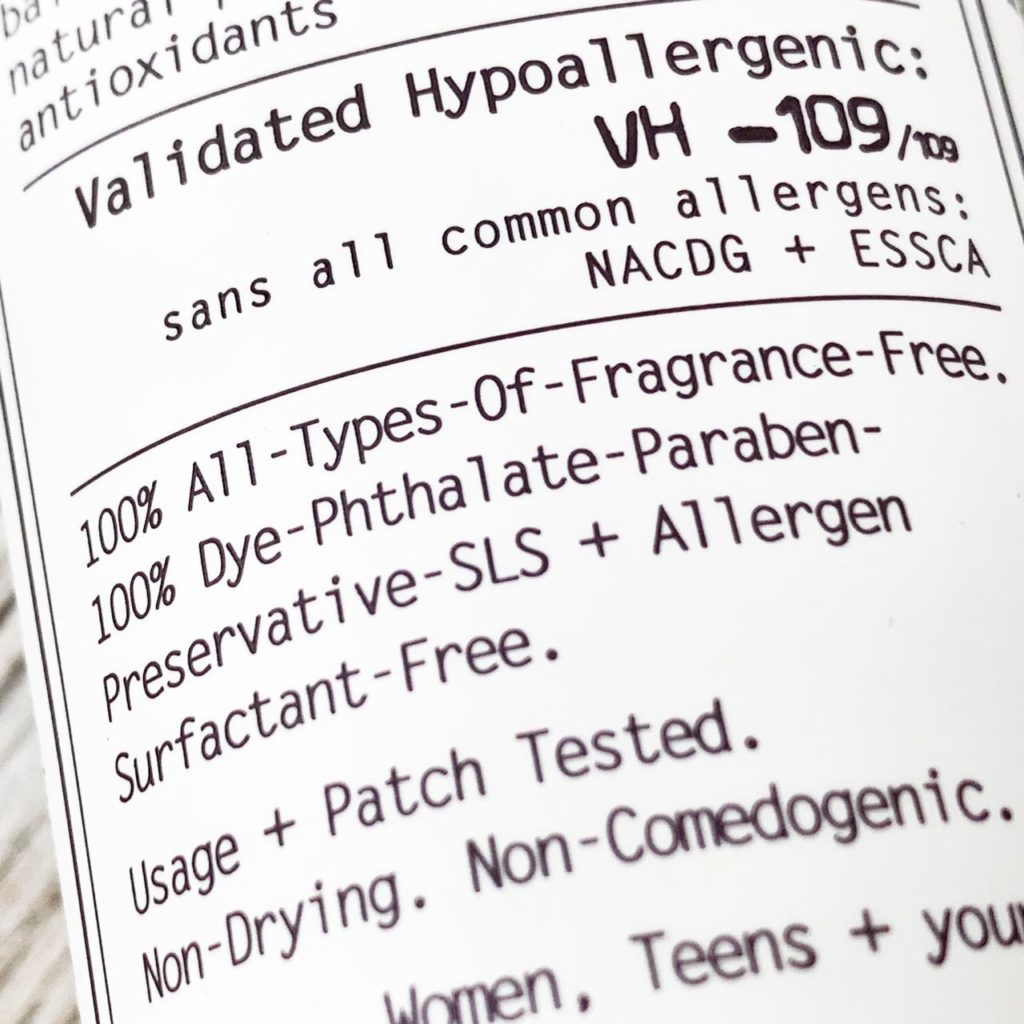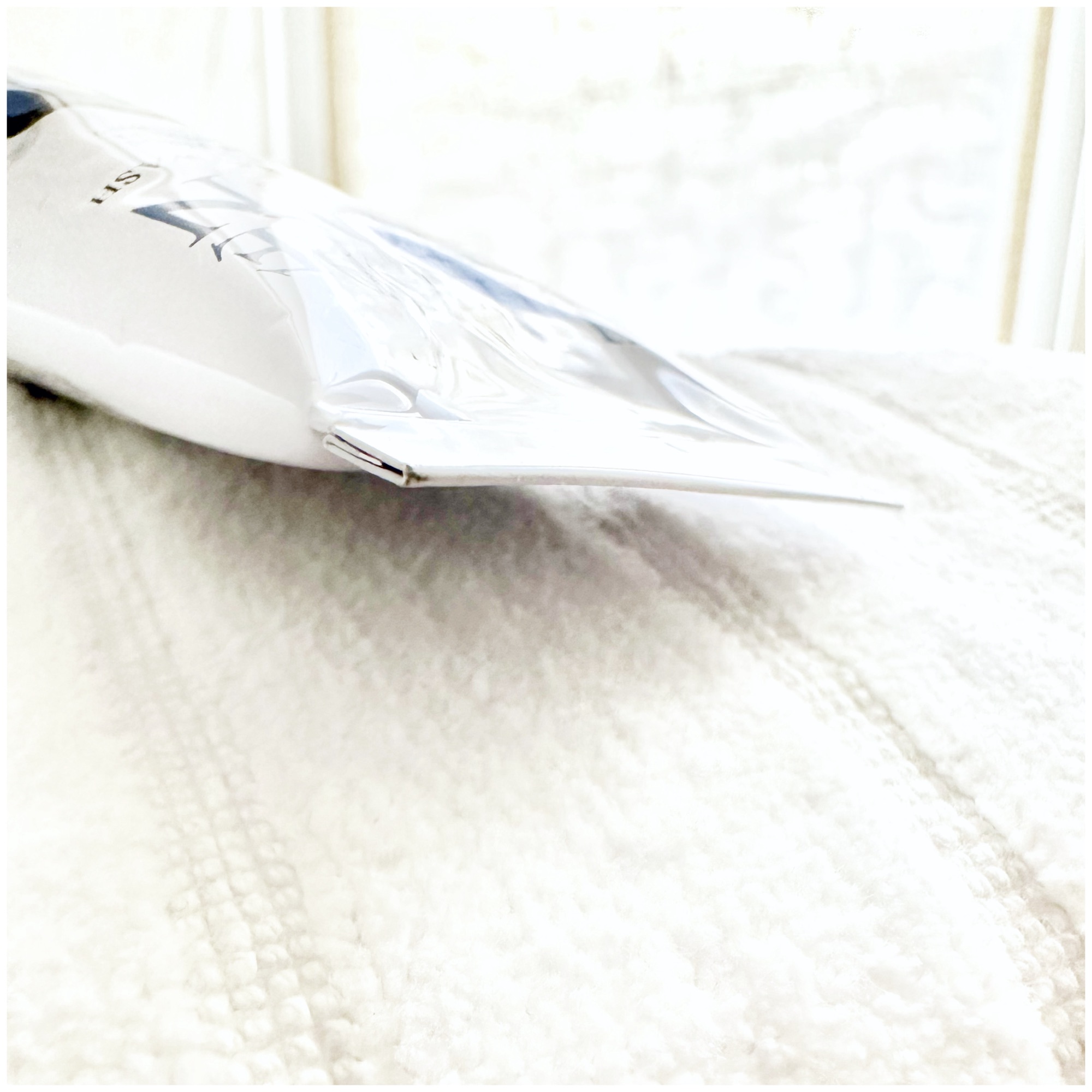Marcie Mom from EczemaBlues.com interviews Laura, CEO of VMV Hypoallergenics, to find out more about product claims and why they’re important when choosing your skin care…particularly if you or your child has eczema.
So many products claim “X-FREE!” and there’s lots online about ingredients that are toxic or otherwise harmful. What’s real? Should parents use a product that says “X-Free”?
A: It depends on the “X.” 🙂 A lot of marketing-speak says “free this” and “free that” but unless you’ve really done your homework and have an expert-level understanding of ingredients and allergens, you might not be able to correctly judge:
- If the offending ingredient is indeed absent — it could be present but listed with a name you do not recognize;
- If cross reactants or related ingredients are present — which can cause the same problems as the “X” in “X-Free”; or
- Whether the omitted ingredient is harmful to begin with.
“X-FREE!” is a powerful marketing phrase on its own whether or not it has objective merit. That is, “X-Free” makes the product sound safer whether or not it is. In some cases, the X could actually be a beneficial ingredient…but tagging “free” onto it immediately makes it sound sinister.
One thing that might help is if the “X” in “X-free” is more specific because it could imply that the manufacturer is being really careful about what they’re claiming. But this, as you’ll see below, is not always the case.
Here are some examples of how the “ingredient-free” claim might not be so straightforward:
“Sulfate-Free” or “SLS-Free”
“Sulfate-free” sounds safer for allergic or eczematous skin but sulfates aren’t allergens so their omission might not be necessary. Importantly, many of the ingredients used to replace sulfates are published contact allergens and are more likely to cause skin and scalp problems. “Amido-amine” surfactants, for example, like CocAMIDE-Dea, CocAMIDOpropyl-Betaine, and CocAMIDOpropyl Hydroxysultaine are common allergens and are frequently used in “Sulfate-Free” cleansers and shampoos. So if you’re looking for more hypoallergenic products that are safer for extremely sensitive skin, “SLS-Free” may be exactly what not to choose if they contain “amid-amines” instead.
“SLS-Free” is better because it’s more specific. But there are two ingredients with the initials SLS: Sodium LauRYL Sulfate and Sodium LaurETH Sulfate. Neither are common contact allergens but the former (laurYL) is a well-known skin irritant. The latter (laurETH) can also be an irritant but far less so, and particularly in lower concentrations.
“Free of Cancer-Causing Ingredients”
When you read a lot about ingredients that “cause cancer”, it’s natural to worry. These claims are serious and you don’t want to take them lightly. However, it is important to remember that some of these reports are skewed to be sensational — they may not be balanced. For instance, much of the evidence of the carcinogenicity of certain ingredients is determined in laboratory experiments with animals fed the ingredient in very high doses (sometimes the equivalent of the animal’s body weight and the equivalent of a lifetime of consumption at these doses). Some of the same ingredients used in cosmetics are present in minuscule or even trace amounts and in molecular sizes that are too large to penetrate the dermis, much less get to the bloodstream. An example would be parabens. We stopped using them because they are allergens, not because of the cancer panic. There simply is not enough to go on. Both the US FDA and American Cancer Society (ACS) independently point out that the study that found parabens in breast tumors does not conclude that parabens caused the tumors. The ACS states, “The study did not show that parabens caused or contributed to breast cancer development in these cases—it only showed that they were there. What this means is not yet clear.”
What causes cancer is a complex question. Birth control pills were once discouraged to prevent breast cancer, but newer studies show that they may prevent other types of cancer in women. If you have been treated for cancer, trust your oncologist because cancer — even the same type of cancer — is not the same for everyone. Ask your doctor what skincare and makeup ingredients you can feel safe using. They should be able to guide you better based on the ingredients themselves, the concentrations normally found in cosmetics, and your particular cancer and history.
“Mineral Oil-Free”
Mineral oil is an excellent ingredient that has gotten a bad reputation. It is NOT an allergen and is a dermatological staple. Ask any dermatologist and they’ll tell you mineral oil is a go-to, reliable hydrator even for extremely sensitive skin and even for sensitive areas like the genitalia. There are some reports of comedogenicity but it is otherwise a reliable moisturizer.
“Alcohol-Free”
Many of us think that alcohol is a liquid that dries out the skin but this is not the case. Some alcohols should be avoided, but many alcohols are actually safe and even good for the skin. “Alcohol” is merely a categorization based on atomic structure. Most alcohols are waxes (and waxes aren’t drying). Sperm oil, jojoba, rapeseed, mustard, tallow, beeswax, and many other plant ingredients, for example, are alcohols.
If a product says “alcohol-free,” what does that mean? Methyl alcohol (“wood alcohol”) is derived from methanol. Used for industrial and automotive purposes, it is poisonous on the skin and is not approved for cosmetic applications. Short-chain fatty alcohols are generally considered eye irritants, while long-chain alcohols are not. Benzyl alcohol is related to fragrance and is an allergen. Cinnamic alcohol is a fragrance and an allergen. “Alcohol-free” in these cases is a good thing — in the case of methyl alcohol, it would be illegal for a product to contain it.
But what about lanolin? This fatty substance from sheep’s wool is an alcohol, is not drying, is highly moisturizing, but is a common contact allergen. Because the “alcohol-free” claim seems to target consumers looking for “non-drying” products (which is an important concern for very dry or allergic skin) and because “alcohol-free” is not a regulated claim, lanolin could be present in an “alcohol-free” product. If you’re allergic to lanolin and it is present in an “alcohol-free” product, “alcohol-free” wouldn’t be helpful to you at all. In this case, “lanolin-free,” “allergen-free,” or “non-drying” would serve you better.
In yet other cases, “alcohol-free” may be a not-so-great thing. Ethyl alcohol is not known to cause irritations. Isopropyl alcohol is “good” in that it is a reliable antiseptic, it is not a common contact allergen, and it is accepted for cosmetics. Stearyl and cetearyl alcohol are waxes needed by many formulations to mix and, based on the latest publication of common allergens, are not known to irritate skin. Other alcohols are beneficial to skin, like those from coconut and palm oils. “Alcohol-free” in these cases is a disadvantage.
“Fragrance-Free”
As a rule, this claim is important for those with contact dermatitis or skin allergies. But even a product that says “fragrance-free” may contain fragrances or products that are related to fragrance. As dermatologist Dr. Rajana Katta shares,
Even using products labeled “fragrance-free” or “unscented” may not help, as some of these can legally contain fragrance additives. In fact, a recent US study that looked at best-selling body moisturizers found that for products that claimed to be “fragrance free,” 45% of these products actually contained at least 1 fragrance cross-reactor or botanical ingredient.
Yes, definitely, “fragrance-free” is important but are you confident that you know all the chemical names of all substances that are fragrances or masking fragrances, or that cross-react with/are related to them (e.g. cinnamic alcohol)?
At VMV Hypoallergenics, we claim “all-types-of-fragrance-free” to indicate that a formulation is free of fragrances, scents, masking fragrances, and ingredients that are not called fragrances but are related to them.
“Free of Toxic Ingredients”
This claim makes us uncomfortable because we feel that it fuels an inaccurate myth of toxicity in skincare and makeup. The cosmetics industry is regulated in most markets and nothing”toxic” in the real sense of the word (poisonous) is allowed in cosmetics. Ingredients (and often their concentrations) are reviewed by regulators to ensure that nothing toxic is included in cosmetics as these products are intended for use on the skin, which is a major organ.
“Allergen-Free”
This claim seems clearer but neither “allergen-free” nor “hypoallergenic” are regulated claims. Many ingredients touted for sensitive skin are actually highly allergenic. Some natural and/or organic ingredients are allergens, too. Which is why at VMV, we state “validated as hypoallergenic” which means that we patch test all our ingredients and final formulations. We also rate how many allergens are included (or not) in a formulation. Furthermore, the ingredients list highlights any allergens that are in the formulation so that you know whether you can use the product — if it contains an allergen but not one of yours, it should be safe to use.
When you see “allergen-free,” make sure that the brand is referring to proven and published common contact allergens. The North American Contact Dermatitis Group and European Surveillance System on Contact Allergies patch test over 20,000 people in multiple countries to compile their lists of allergens. They regularly publish their findings and, crucially, they update these lists every few years. These lists are statistically relevant, consistently updated, and put together by two of the most respected groups of doctors in the world who concentrate on allergens and contact dermatitis. This allergen list is what our VH-Rating System uses and, considering we’ve had less than 0.1% reported reactions in 30 years, it’s quite reliable.
Allergenicity is different for everyone; we have different tolerances. But what VMV has done is to validate the claim (by patch tests and using an exclusion list based on common allergens published by objective, independent sources) and to standardize how the claim is used (with a clear, simple method of allergen omission). This decreases the probability of allergic reactions and is a valid, evidenced-based claim.
This article was originally published in eczemablues.com as one of a multi-part series focused on understanding and using products for sensitive skin. Inspired by her daughter Marcie who had eczema from two weeks old, Mei (aka MarcieMom) started EczemaBlues.com with the mission to turn eczema blues to bliss. In this series of interviews, MarcieMom interviews Laura, CEO of VMV Hypoallergenics, to learn more about product claims when choosing products to care for skin with eczema.







